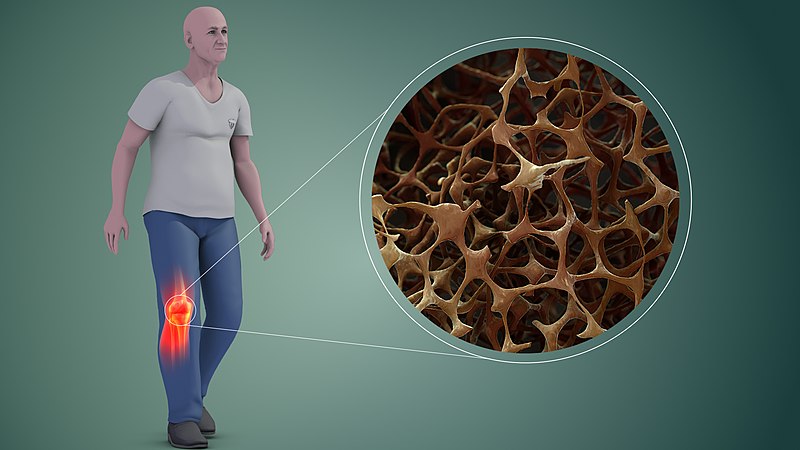What is the Difference Between Osteogenesis Imperfecta and Osteoporosis
Table of Contents
The key difference between osteogenesis imperfecta and osteoporosis is that osteogenesis imperfecta (Brittle Bone Disease) is a genetic disorder that causes abnormal bone formation, while osteoporosis is a genetic disorder that causes loss of bone density.
Bones normally help people to move. They also give shape and support to the body. Bones are living tissues that constantly rebuild throughout life. During childhood and teenage, the body makes new bones faster than it removes old bones. But after about age 20, the human body loses bones faster than it makes bones. To get stronger bones, in adulthood, people should consume enough calcium and vitamin D throughout their lifetime. People also should exercise properly and avoid smoking and drinking to maintain stronger bones. Bone diseases can make bones easy to break. Osteogenesis imperfecta and osteoporosis are two different kinds of bone diseases.
CONTENTS
1. Overview and Key Difference
2. What is Osteogenesis Imperfecta (Brittle Bone Disease)
3. What is Osteoporosis
4. Similarities – Osteogenesis Imperfecta and Osteoporosis
5. Osteogenesis Imperfecta vs Osteoporosis in Tabular Form
6. Summary – Osteogenesis Imperfecta vs Osteoporosis
What is Osteogenesis Imperfecta (Brittle Bone Disease)?
Osteogenesis imperfecta is a genetic disorder that causes abnormal bone formation. It is an inherited genetic disorder present from birth. It is also named brittle bone disease. A child born with this disease has soft bones that tend to break very easily. The bones are not formed normally. The signs and symptoms can range from mild to severe. The symptoms may include easily broken bones, bone deformities, discolouration of the white part of the eye, barrel-shaped chest, curved spine, triangle-shaped face, loose joint, muscle weakness, etc.

Figure 01: Osteogenesis Imperfecta
There are at least 8 different types of osteogenesis imperfecta. Osteogenesis imperfecta can occur due to several gene mutations. Mutations in COL1A1 and COL1A2 genes cause approximately 90% of all cases. Some mutations are sporadic. Therefore, babies that are born with mutations have problems in bone making due to connective tissue. This is caused by a lack of type 1 collagen. Generally, collagen is found in bones, ligaments, and teeth that make them strong. Ultimately, the bone may weaken. This condition can be diagnosed through blood tests (for gene mutation) and bone density tests (through X-ray). The treatment options include occupational therapy, physical therapy, assistive devices, oral and dental care, and medications to slow down bone loss and pain.
What is Osteoporosis?
Osteoporosis is a genetic disorder that causes loss of bone density. Osteoporosis causes bone weakness and makes them more susceptible to sudden and unexpected fractures. Osteoporosis means that people may have less bone mass and less strength. Women are four times more likely to get osteoporosis than men. At least 15 gene mutations have been confirmed as osteoporosis causing gene mutations. Some of the genes involved in osteoporosis are ESRI, LRP5, SOST, OPG, RANK, and RANKL. Moreover, another 30 genes have been highlighted as susceptibility genes. These gene mutations can be sporadic or inherited. Furthermore, these genes participate in chemical signaling pathways that affect the development of cells and tissues. They are also involved in the regulation of bone mineral density.

Figure 02: Osteoporosis
The symptoms may include back pain, loss of height over time, a stooped posture, and easily breaking bones. Generally, this medical condition can be diagnosed through X-ray, CT scan, spine CT, and bone density scan. The treatment options include medications like bisphosphonates, calcitonin, hormone therapy, RANK ligand inhibitor, selective estrogen receptor modulators, and parathyroid hormone analog. The most common surgical techniques for treating this medical condition are vertebroplasty and kyphoplasty.
What are the Similarities Between Osteogenesis Imperfecta and Osteoporosis?
- Osteogenesis imperfecta and osteoporosis are two different bone diseases.
- Both medical conditions can be present from childhood itself.
- They can occur due to inherited or sporadic gene mutations.
- Both medical conditions may cause bone fractures.
- They are treatable medical conditions.
What is the Difference Between Osteogenesis Imperfecta and Osteoporosis?
Osteogenesis imperfecta is a genetic disorder that causes abnormal bone formation, while osteoporosis is a genetic disorder that causes loss of bone density. Thus, this is the key difference between osteogenesis imperfecta and osteoporosis. Furthermore, osteogenesis imperfecta affects both men and women equally, while osteoporosis affects women more than men.
The below infographic presents the differences between osteogenesis imperfecta and osteoporosis in tabular form for side by side comparison.
Summary – Osteogenesis Imperfecta vs Osteoporosis
Osteogenesis imperfecta and osteoporosis are two different kinds of bone diseases. Both these medical conditions can be due to inherited or sporadic gene mutations. Osteogenesis imperfecta is a genetic disorder that causes abnormal bone formation, while osteoporosis is a genetic disorder that causes loss of bone density. So, this is the key difference between osteogenesis imperfecta and osteoporosis.
Reference:
1. “Osteoporosis.” NHS Choices, NHS.
2. “Osteogenesis Imperfecta.” NORD (National Organization for Rare Disorders).
Image Courtesy:
1. “Osteogenesis Imperfecta Type V” By ShakataGaNai (CC BY-SA 4.0) via Commons Wikimedia
2. “Osteoporosis in Bones” By Scientificanimations– (CC BY-SA 4.0) via Commons Wikimedia
ncG1vNJzZmivp6x7pbXFn5yrnZ6YsqOx07CcnqZemLyue9ahmK1lmah6tbTEZpuinpaav6a6wp5km52krLKmuoyoqq2dn5yyr7HSoqpmoZ2lsrOyxJyrmmWRo7Fuu9KtnKion6e8tLXSaA%3D%3D